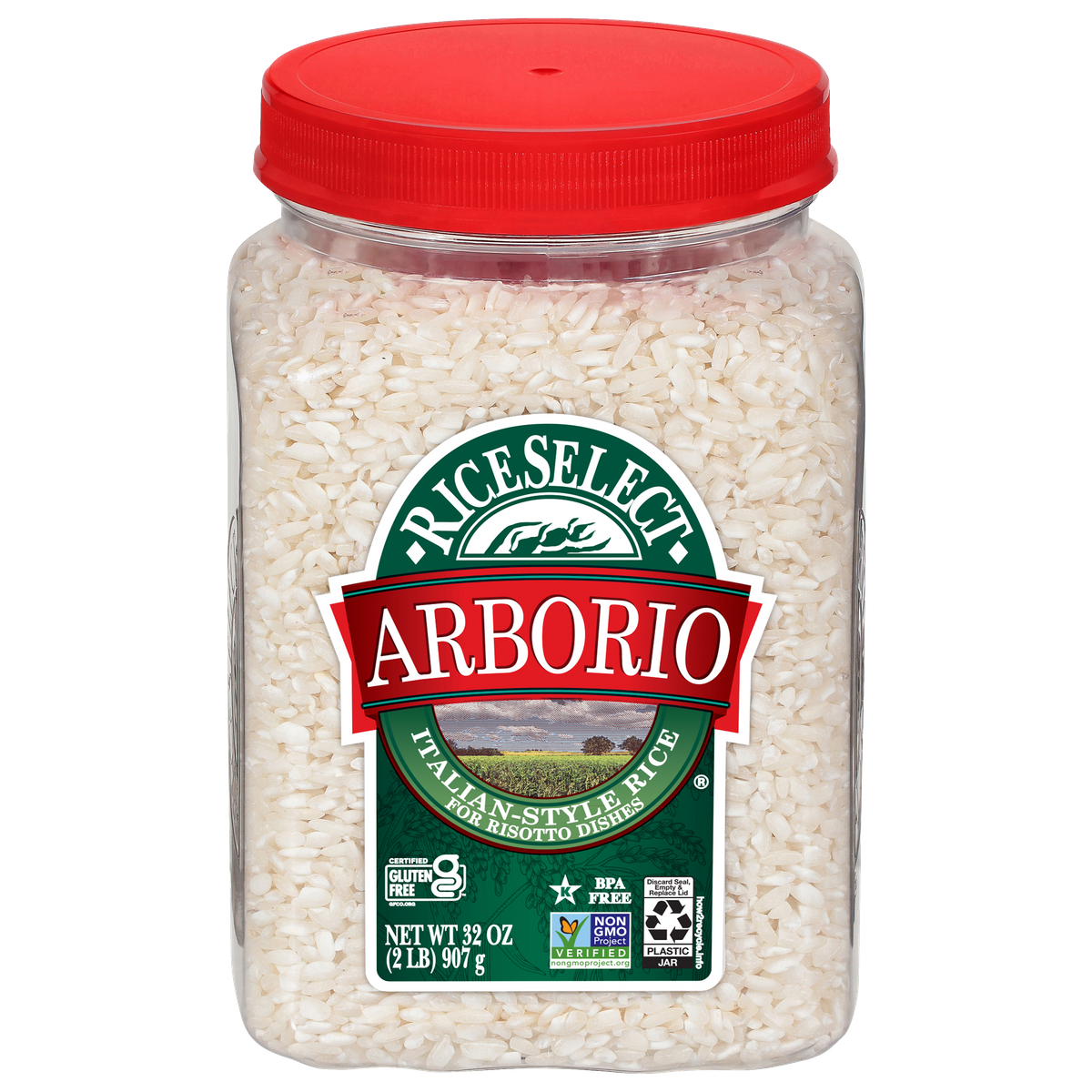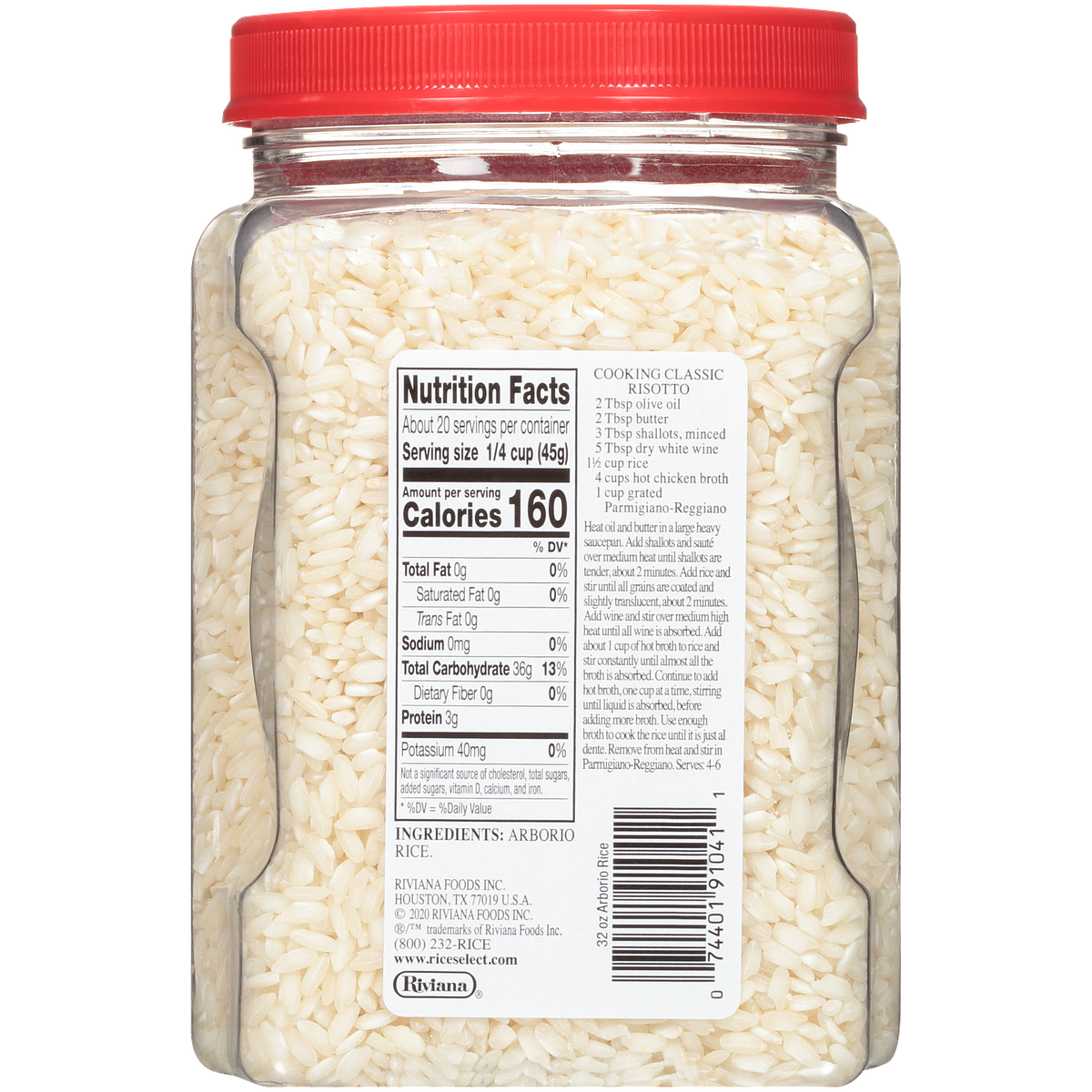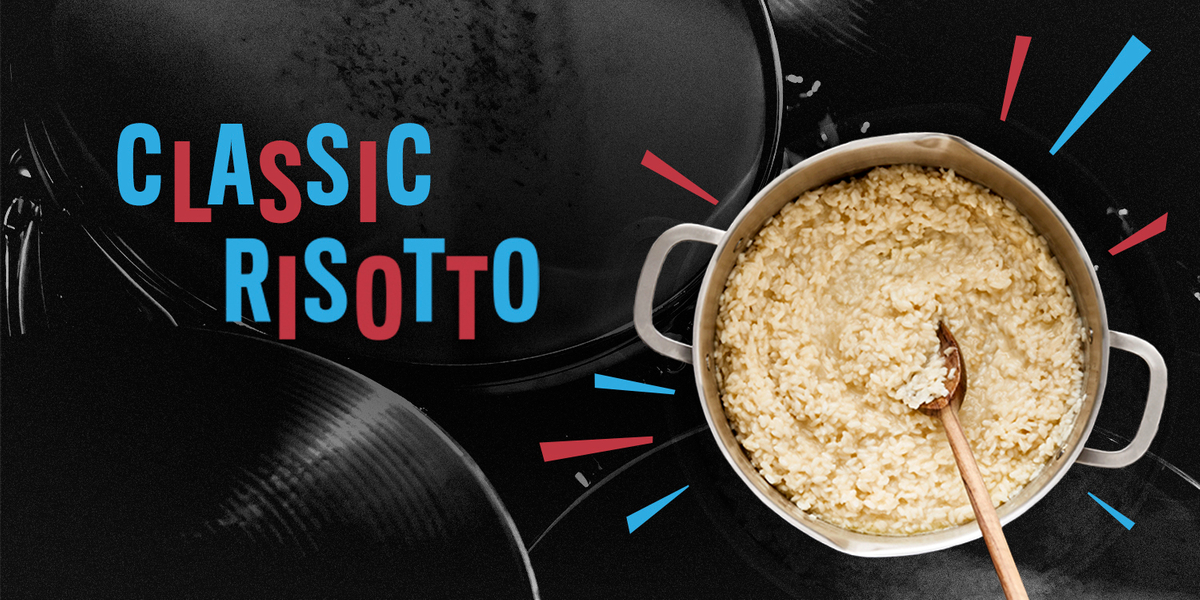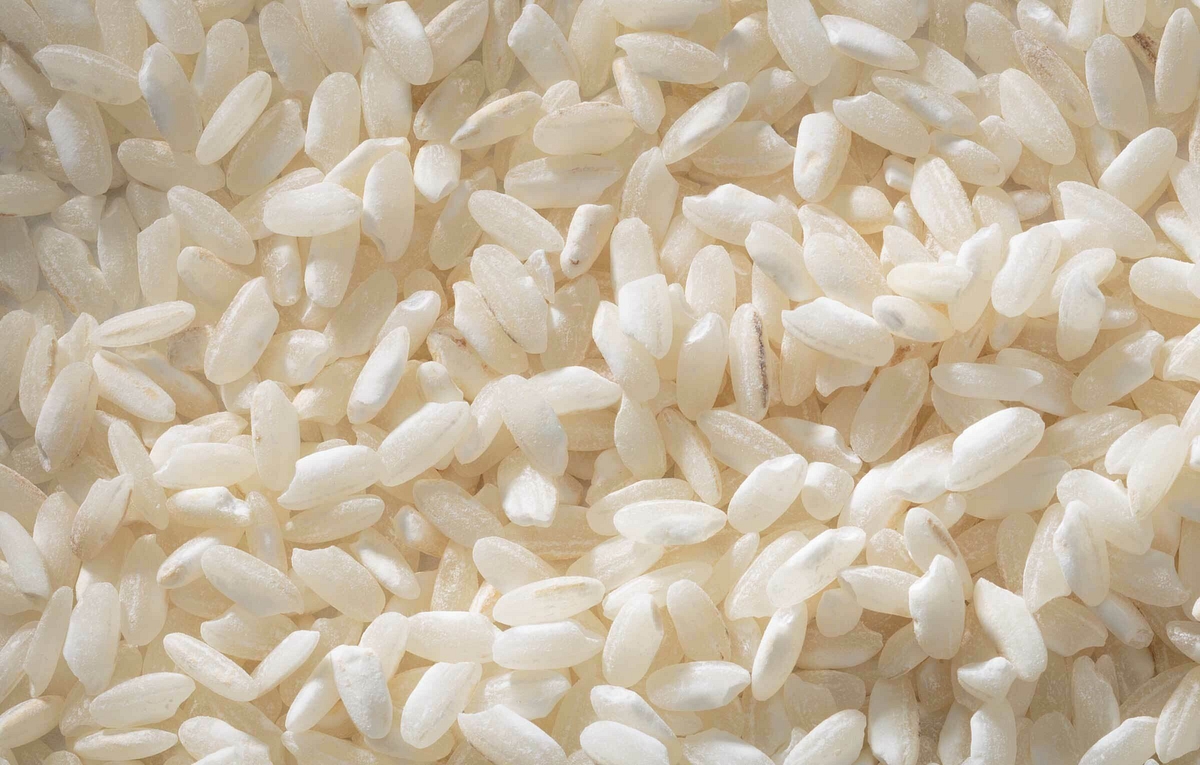What is Arborio Rice?
Arborio is The Risotto Rice. With a vibrant burst of inspiration arborio rice will elevate your next dish into something truly unforgettable. An essential ingredient in classic risotto recipes, the bold, medium-grain rice is high in starch, giving the dish its signature silky texture and al dente bite. Served in our iconic transparent jar with the distinct red cap, our Arborio rice is of the most discerning quality, offering versatility for an impressive and eclectic array of creative culinary endeavors.
Benefits
- Certified Gluten Free
- Non-GMO Project Verified
- Certified Kosher by Star K
- Packaged in a 100% recyclable, BPA-Free jar
- No preservatives or additives and low in fat, cholesterol, and sodium
{{h2r}}
Rice for Risotto
RiceSelect® Arborio Rice is perfect for tasty risotto dishes due to its silky texture. There are plenty of ways to make risotto, however one of our favorite dishes is this Curry Risotto With Baked Salmon recipe made with creamy coconut milk.
Can Other Rice Varieties be Used for Risotto?
Yes, within reason you can use pretty much any rice you want to make risotto. That said, the flavor and texture of arborio rice makes it ideal for making traditional style risotto.
Arborio Rice for Paella
Although Spanish Bomba Rice is normally used for traditional Paella, RiceSelect® Arborio Rice also works perfectly well. Both arborio and bomba rice varieties are short grain varieties so they are already very similar, however the latter is slightly more absorbent. Try making paella with RiceSelect® Arborio Rice in this Easy Paella Recipe.
Arborio Rice Calories
A serving RiceSelect® Arborio Rice contains approximately 160 calories meaning that it contains less calories than other rice types.
Classic Risotto Recipe
- 2 tablespoons olive oil
- 2 tablespoons butter
- 3 tablespoons shallots, minced
- 5 tablespoons dry white wine
- 1 ½ cups rice
- 4 cups hot chicken broth
- 1 cup grated Parmigiano-Reggiano
Heat oil and butter in a large heavy saucepan. Add shallots and saute over medium heat until shallots are tender about 2 minutes. Add rice and stir until all grains are coated and slightly translucent, about 2 minutes. Add wine and stir over medium-high heat until all wine is absorbed. Add about 1 cup of hot broth to rice and stir constantly until almost all the broth is absorbed. Continue to add hot broth, one cup at a time, stirring until liquid is absorbed, before adding more broth. Use enough broth to cook the rice until it is just al dente. Remove from heat and stir in Parmigiano-Reggiano. Serves: 4-6
How to Cook Arborio Rice
If you’d like to use arborio rice for a recipe that is not risotto, or simply serve it as a creamy bed of rice, it can be prepared in the same way as other rice varieties.
The ratio of rice to water is 1 cup of rice for 2 cups of water (or other cooking liquid such as broth, juice, or coconut milk). Simply bring the liquid to a boil, add salt or butter if desired, cover and reduce heat to medium-low. Simmer until the cooking liquid is fully absorbed and the rice is al dente, which may take about 20 minutes.
What is Risotto Rice?
Often referred to as risotto rice, arborio rice is famed for its starring role in the delicious Italian comfort food dish. On account of the high starch content, medium-grain arborio is the ideal choice for achieving that signature rich and creamy texture you crave when imagining risotto.
How to Cook Risotto Rice
Using our classic risotto recipe listed above, we’ve put together a few key tips to making your risotto rice the best yet!
Tips for Cooking Risotto Rice:
Add in warm stock or broth. Cold broth will cool your dish and pan, ultimately slowing the process and cooking the rice unevenly for an undesired texture. Keep your broth at a simmer in a pot close by.
Stir often but not constantly. If you stir too often it may make your dish gluey, so it’s best to stir often to avoid sticking and make sure that the grains release their starch and bump into each other.
Cook the rice to al dente. Just like pasta, you’ll need to cook your rice to al dente, with a slightly chewy bite to avoid a mushy texture.
Once you’ve mastered traditional risotto, why not try a creative pairing like in our Seafood Risotto or Mushroom Risotto. If you’re interested in more, find additional flavor pairings in our FAQ section below.
Risotto FAQ's
- A risotto’s “creaminess” is determined by a combination of factors: rice type, temperature, tools, and (perhaps the most difficult to master) patience.
- The reason Arborio rice is preferred for achieving the ideal level of creaminess is its unique starch content. Low or high starch rice proves too sticky or loose to merit the ideal texture. RiceSelect ensures a strict culinary standard for its Arborio starch content, which makes it a terrific choice for accomplishing creamier risottos.
- The aforementioned “Risotto Method” is another important technique to unlock maximum creaminess. When hot liquid is added in small increments, the starch of the rice relaxes and releases slowly into the pot. By contrast, adding cold liquid stops this process, seizing up the starch and making a risotto too sticky or “gummy.”
- The amount of liquid is extremely important too, as too much of it will drown the grain. Be patient — slowly add ½ cup of hot broth to the rice and be aware of how the texture of the rice feels while stirring. All liquid in the pot should be fully absorbed before adding more.
- Creamy risotto takes a little extra effort. Constant stirring is required to keep the starches flowing and integrating throughout the dish. Using a risotto spoon for stirring is preferred, as the hole in its center allows the risotto to be mixed without breaking the grains, resulting in a smoother flow of starches releasing.
- Keep an eye on temperature. Maintain a consistent medium heat for a constant simmer to ensure proper continued starch release. This will also prevent scorching.
- If you want to up the creaminess factor even more, add a bit of mascarpone cheese upon finish for an extra indulgent, creamy touch.
- Risotto offers an incredible base for experimentation and improvisation in the kitchen. Arborio, its base grain, lends itself well to both sweet and savory dishes, given its absorbency. While a lot of people love the simplicity of a classic risotto, you can substitute your favorite broth (Chicken, Beef, Seafood or Vegetable) for a subtle variation in flavor profile, or to address dietary restrictions.
- If you’re feeling adventurous, add a protein, gorgeous spring vegetables, or turn into an elevated dessert.
- A wooden risotto spoon is preferred since it protects your pan due to the amount of stirring required. The hole in the center of the spoon allows for constant flow and minimal grain breakage while stirring.
- A wide, 3-4 quart, heavy-bottom pan is ideal for enabling heat conductivity and steady liquid absorption while cooking.
- To reduce the chances of over-salting your risotto, begin with a low-sodium broth. Keep in mind that many ingredients typically added in risotto recipes contain additional salt (e.g. cheese). Taste frequently throughout the cooking process and adjust accordingly.
- If your risotto ends up over salted, try cooking 1 cup Arborio rice separately with a 2:1 Water-to-Rice ratio and boil for 20 minutes or until all liquid is absorbed. Fluff with fork and stir into the finished risotto to help even out the salt levels as needed.
- If your risotto is not creamy enough, avoid adding butter or cream. This is where patience comes in. Continue to add liquid and stir. The starches will continue to release until desired consistency is reached.
- Believe it or not, you can reheat risotto leftovers. Simply reconstitute with hot broth on the cook top using the Risotto Method until desired consistency is reached. Adding hot broth allows the risotto to come up to temperature gradually, relaxing the starches and restoring the creamy consistency.
- Alternatively, you can turn leftover risotto into delicious Arancini rice balls. Traditional preparation requires refrigeration overnight for optimal formation. Try our Sausage and Sage Arancini Recipe
- Arborio rice can be used in an eclectic variety of dishes besides Risotto. It makes a delicious, creamy side on its own or can be used in Arancini rice balls, like in this recipe Crab Cake Arancini.
- For preparation of Arborio rice on its own, bring 2 cups water to boil. If desired, add salt and olive oil or butter. Stir in 1 cup of rice. Cover. Reduce heat and simmer for 20 minutes or until all water is absorbed. Makes about 3 cups cooked rice.






